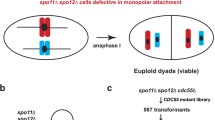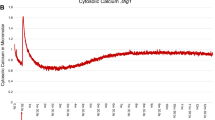Abstract
The role of calmodulin (CaM) during mating in Saccharomyces cerevisiae was examined by using a set of Phe-to-Ala substitutions. We identified ten CaM mutants that exhibited significantly reduced mating efficiencies when crossed to a strain of the opposite mating type harboring the same CaM mutation. Most of the mating-defective CaM mutants were bilateral, i.e., they also exhibited mating defects, albeit minor ones, when crossed to the wild type. When strains carrying different bilateral CaM mutations were mated, the mating efficiencies recovered dramatically. We termed this phenomenon "intragenic mating complementation", and classified the mating-defective CaM mutations into two intragenic mating complementation groups. Two mutant alleles belonging to different groups showed minor defects in cell adhesion and cell fusion, but exhibited severe defects in karyogamy. CaM is known to bind to the essential spindle pole body component Nuf1p. This binding appears to be important for karyogamy because the nuf1 C911R mutation, which impairs CaM-Nuf1p binding, resulted in a severe defect in karyogamy. Indeed, the two mating-defective CaM mutations were found to compromise formation of the CaM/Nuf1p complex, and the mating defects of these two CaM mutants were suppressible by a dominant, CaM-independent, mutation in NUF1. Taken together, these results suggest that loss of CaM binding to Nuf1p causes a defect in karyogamy, thereby inhibiting productive mating.









Similar content being viewed by others
References
Brockerhoff SE, Stevens RC, Davis TN (1994) The unconventional myosin, Myo2p, is a calmodulin target at sites of cell growth in Saccharomyces cerevisiae. J Cell Biol 124:315–323
Byers B, Goetsch L (1975) Behavior of spindles and spindle plaques in the cell cycle and conjugation in Saccharomyces cerevisiae. J Bacteriol 124:511–523
Cohen P, Klee CB (eds) (1988) Calmodulin (Molecular aspects of cellular regulation, vol 5). Elsevier Biomedical Science, Amsterdam
Conde J, Fink GR (1976) A mutant of Saccharomyces cerevisiae defective for nuclear fusion. Proc Natl Acad Sci USA 73:3651–3655
Cyert MS, Thorner J (1992) Regulatory subunit ( CNB1gene product) of yeast Ca2+/calmodulin-dependent phosphoprotein phosphatases is required for adaptation to pheromone. Mol Cell Biol 12:3460-3469
Cyert MS, Kunisawa R, Kaim D, Thorner J (1991) Yeast has homologs ( CNA1and CNA2 gene products) of mammalian calcineurin, a calmodulin-regulated phosphoprotein phosphatase. Proc Natl Acad Sci USA 88:7376–7380
Davis TN, Urdea MS, Masiarz FR, Thorner J (1986) Isolation of the yeast calmodulin gene: calmodulin is an essential protein. Cell 47:423–431
Delgado MA, Conde J (1984) Benomyl prevents nuclear fusion in Saccharomyces cerevisiae. Mol Gen Genet 193:188–189
Desrivieres S, Cooke FT, Morales-Johansson H, Parker PJ, Hall MN (2002) Calmodulin controls organization of the actin cytoskeleton via regulation of phosphatidylinositol (4,5)-bisphosphate synthesis in Saccharomyces cerevisiae. Biochem J 366:945–951
Geiser JR, Sundberg HA, Chang BH, Muller EG, Davis TN (1993) The essential mitotic target of calmodulin is the 110-kilodalton component of the spindle pole body in Saccharomyces cerevisiae. Mol Cell Biol 13:7913–7924
Geli MI, Wesp A, Riezman H (1998) Distince functions of calmodulin are required for the uptake step of receptor-mediated endocytosis in yeast: the type I myosin Myo5p is one of the calmodulin targets. EMBO J 17:635–647
Govindan B, Bowser R, Novick P (1995) The role of Myo2p, a yeast class V myosin, in vesicular transport. J Cell Biol 128:1055–1068
Ho Y, et al (2002) Systematic identification of protein complexes in Saccharomyces cerevisiae by mass spectrometry. Nature 415:180–183
Huffaker TC, Thomas JH, Botstein D (1988). Diverse effects of β-tublin mutations on microtubule formation and function. J Cell Biol 106:1997–2010
Iida H, Yagawa Y, Anraku Y (1990) Essential role for induced Ca2+ influx followed by [Ca2+] i rise in maintaining viability of yeast cells late in the mating pheromone response pathway. J Biol Chem 265:13391–13399
Johnston GC, Prendergast JA, Singer RA (1991) The Saccharomyces cerevisiae MYO2 gene encodes an essential myosin for vectorial transport of vesicles. J Cell Biol 113:539–551
Kaiser C, Michaelis S, Mitchell A (1994) Methods in yeast genetics: a laboratory course manual. Cold Spring Harbor Laboratory Press, Cold Spring Harbor, N.Y.
Kilmartin JV, Goh PY (1996) Spc110p: assembly properties and role in the connection of nuclear microtubules to the yeast spindle pole body. EMBO J 15:4592–4602
Kilmartin JV, Dyos SL, Kershaw D, Finch JT (1993) A spacer protein in the Saccharomyces cerevisiae spindle poly body whose transcript is cell cycle-regulated. J Cell Biol 123:1175–1184
Knop M, Schiebel E (1997) Spc98p and Spc97p of the yeast γ-tubulin complex mediate binding to the spindle pole body via their interaction with Spc110p. EMBO J 16:6985–6995
Kubler E, Schimmoller F, Reizman H (1994) Calcium-independent calmodulin requirement for endocytosis in yeast. EMBO J 13:5539–5546
Li CJ, Heim R, Lu P, Pu Y, Tsien RY, Chang DC (1999) Dynamic redistribution of calmodulin in HeLa cells during cell division as revealed by a GFP-calmodulin fusion protein technique. J Cell Sci 112:1567–1577
Liu Y, Ishii S, Tokai M, Tsutsumi H, Ohki O, Akada R, Tanaka K, Tsuchiya E, Fukui S, Miyakawa T (1991) The Saccharomyces cerevisiae genes ( CMP1and CMP2) encoding calmodulin-binding proteins homologous to the catalytic subunit of mammalian protein phosphatase 2B. Mol Gen Genet 227:52–59
Marsh L, Rose MD (1997) The pathway of cell and nuclear fusion during mating in S. cerevisiae. In: Pringle JR, Broach JR, Jones EW (eds) The Molecular and cellular biology of the yeast Saccharomyces cerevisiae: cell cycle and cell biology. Cold Spring Harbor Laboratory Press, Cold Spring Harbor, N.Y., pp 827–888
Mirzayan C, Copeland CS, Snyder M (1992) The NUF1 gene encodes an essential coiled-coil related protein that is a potential component of the yeast nucleoskeleton. J Cell Biol 116:1319–1332
Moser MJ, Geiser JR, Davis TN (1996) Ca2+-calmodulin promotes survival of pheromone-induced growth arrest by activation of calcineurin and Ca2+-calmodulin-dependent protein kinase. Mol Cell Biol 16:4824–4831
Ohya Y, Botstein D (1994a) Diverse essential functions revealed by complementing yeast calmodulin mutants. Science 263:963–966
Ohya Y, Botstein D (1994b) Structure-based systematic isolation of conditional-lethal mutations in the single yeast calmodulin gene. Genetics 138:1041–1054
Ohya Y, Kawasaki H, Suzuki K, Londesborough J, Anraku Y (1991) Two yeast genes encoding calmodulin-dependent protein kinases. Isolation, sequencing and bacterial expressions of CMK1 and CMK2. J Biol Chem 266:12784–12794
Okano H, Cyert MS, Ohya Y (1998) Importance of phenylalanine residues of yeast calmodulin for target binding and activation. J Biol Chem 273:26375–26382
Pausch MH, Kaim D, Kunisawa R, Admon A, Thorner J (1991) Multiple Ca2+/calmodulin-dependent protein kinase genes in a unicellular eukaryote. EMBO J 10:1511–1522
Rose MD (1991) Nuclear fusion in yeast. Annu Rev Microbiol 45:539–567
Rose MD, Winston F, Hieter P (1990) Methods in yeast genetics. Cold Spring Harbor Laboratory Press, Cold Spring Harbor, N.Y.
Rossanese OW, Reinke CA, Bevis BJ, Hammond AT, Sears IB, O'Connor J, Glick BS (2001) A role for actin Cdc1p, and Myo2p in the inheritance of late Golgi elements in Saccharomyces cerevisiae. J Cell Biol 153:47–62
Sambrook J, Fritsch EF, Maniatis T (1989) Molecular cloning: a laboratory manual (2nd edn). Cold Spring Harbor Laboratory Press, Cold Spring Harbor, N.Y.
Sekiya-Kawasaki M, Botstein D, Ohya Y (1998) Identification of functional connections between calmodulin and the yeast actin cytoskeleton. Genetics 150:43–58
Sikorski RS, Hieter P (1989) A system of shuttle vectors and yeast host strains designed for efficient manipulation of DNA in Saccharomyces cerevisiae. Genetics 122:19–27
Sprague GFJ, Thorner JW (1994) Pheromone response and signal transduction during the mating process of Saccharomyces cerevisiae. In: Jones EW, Pringle JR, Broach JR (eds) The Molecular and cellular biology of the yeast Saccharomyces cerevisiae: cell cycle and cell biology. Cold Spring Harbor Laboratory Press, Cold Spring Harbor, N.Y., pp 657–744
Stirling DA, Welch KA, Stark MJ (1994) Interaction with calmodulin is required for the function of Spc110p, an essential component of the yeast spindle pole body. EMBO J 13:4329–4342
Stirling DA, Rayner TF, Prescott AR, Stark MJ (1996) Mutations which block the binding of calmodulin to Spc110p cause multiple mitotic defects. J Cell Sci 109:1297–1310
Sundberg HA, Goetsch L, Byers B, Davis TN (1996) Role of calmodulin and Spc110p interaction in the proper assembly of spindle pole body components. J Cell Biol 133:111–124
Tassin AM, Celati C, Paintrand M, Bornens M (1997) Identification of an Spc110p-related protein in vertebrates. J Cell Sci 110:2533–2545
Willingham MC, Wehland J, Klee CB, Richert ND, Rutherford AV, Pastan IH (1983) Ultrastructural immunocytochemical localization of calmodulin in cultured cells. J Histochem Cytochem 31:445–461
Yin H, Pruyne D, Huffaker TC, Bretscher A (2000) Myosin V orientates the mitotic spindle in yeast. Nature 406:1013–1015
Zavortink M, Welsh MJ, McIntosh JR (1983) The distribution of calmodulin in living mitotic cells. Exp Cell Res 149:375–385
Zhu H, Bilgin M, Bangham R, Hall D, Casamayor A, Bertone P, Lan N, Jansen R, Bidlingmaier S, Houfek T, Mitchell T, Miller P, Dean RA, Gerstein M, Snyder M (2001) Global analysis of protein activities using proteome chips. Science 293:2101–2105
Acknowledgements
We would like to thank Hidenori Kimura for encouragement throughout this study, Rino Matsunaga for critically reading the manuscript, and members of the Laboratory of Signal Transduction for helpful discussion. This work was supported by grants from the Ministry of Education, Science and Sports and Culture of Japan to Y. Ohya, and from the Japan Society for the Promotion of Science for Young Scientists to H. Okano
Author information
Authors and Affiliations
Corresponding author
Additional information
Communicated by C. P. Hollenberg
Rights and permissions
About this article
Cite this article
Okano, H., Ohya, Y. Binding of calmodulin to Nuf1p is required for karyogamy in Saccharomyces cerevisiae . Mol Gen Genomics 269, 649–657 (2003). https://doi.org/10.1007/s00438-003-0853-z
Received:
Accepted:
Published:
Issue Date:
DOI: https://doi.org/10.1007/s00438-003-0853-z




